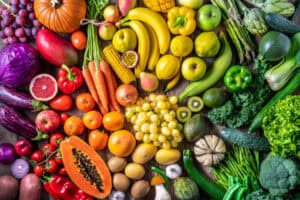What is Healthy Eating?
When it comes to building a healthy meal, the options can feel endless. With so many diets, fads, and conflicting advice, it’s easy to get lost. But at its core, a balanced and nutritious meal is simple, and there are three key elements you should always focus on: a protein source, a fiber source, and plenty of color. Let’s break down why these three components are essential for fueling your body and how to include them in every meal. Quick note before we continue, this is just the basics of eating for health we will not be covering body composition or sports performance just yet!!
1. Protein: The Building Block of Your Body
Protein is a vital macronutrient that helps your body build and repair tissues, produce enzymes and hormones, and support your immune system. Without enough protein, your muscles, bones, and organs can’t function at their best. Protein also helps keep you feeling full longer, making it an essential part of a healthy meal.
Some great sources of protein include:
- Animal-based options: Chicken, turkey, fish, lean beef, eggs, and dairy.
- Plant-based options: Tofu, tempeh, beans, lentils, chickpeas, quinoa, and edamame.
For a well-rounded meal, aim to include about a palm-sized portion of protein, adjusting based on your activity level and dietary needs. Looking for more info on your protein needs? Schedule a nutrition consultation with CJ or check out the nutrition.gov website here!!
2. Fiber: The Digestive Hero
Fiber is crucial for digestive health, helping to regulate bowel movements, prevent constipation, and feed the good bacteria in your gut. It also plays a role in stabilizing blood sugar levels and keeping you full between meals.
There are two types of fiber: soluble and insoluble. Soluble fiber helps lower cholesterol levels, while insoluble fiber adds bulk to stool and supports healthy digestion.
Foods rich in fiber include:
- Fruits: Apples, berries, oranges, pears.
- Vegetables: Broccoli, spinach, carrots, sweet potatoes.
- Whole grains: Brown rice, quinoa, oats, whole-wheat pasta.
- Legumes: Lentils, beans, peas, chickpeas.
Aim to fill half of your plate with fiber-rich vegetables and whole grains for a digestive boost that will keep you satisfied longer.
3. Color: A Sign of Nutrient Variety
When you add more color to your plate, you’re also adding a wide range of nutrients. Different colored fruits and vegetables contain different antioxidants, vitamins, and minerals, which help protect your body from disease, promote heart health, and support immune function. Eating a variety of colorful foods ensures that you’re getting a range of nutrients.
Try to include at least three different colors in every meal. Some colorful options to consider:
- Red: Tomatoes, strawberries, red peppers.
- Orange/Yellow: Sweet potatoes, carrots, bell peppers, mango.
- Green: Spinach, kale, broccoli, zucchini.
- Blue/Purple: Blueberries, eggplant, beets, purple cabbage.

By focusing on adding more color, you make sure you’re getting a variety of nutrients that your body needs to thrive.
Bringing It All Together
Healthy eating shouldn’t drive you crazy, or require 12 obscure ingredients you can only find in one special store. At its core healthy eating needs to be simple. For example, a grilled chicken salad with spinach (green), carrots (orange), and red bell peppers (red), topped with a serving of quinoa or beans for extra fiber, is a great example of a nutrient-packed meal that will keep you energized and satisfied. Don’t forget to switch up your protein, fiber, and colors daily to ensure you’re getting a wide variety of nutrients.
The next time you’re planning your meal, ask yourself: Do I have a protein source? A fiber source? Am I including multiple colors on my plate? If the answer is yes, you’re on the right track to building a healthy, well-rounded meal!
